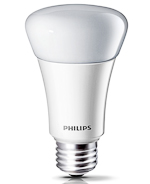An App Store for Home Lighting
Home lighting has gained new status in the world of network-connected digital gadgetry.

Philips today introduced a software development kit for a brand of its LED light bulbs. The APIs let programmers write custom iOS applications for Hue, bulbs that connect to a home network and can be controlled from a smart phone or iPad.
The Hue bulbs connect to a wireless gateway device and let people control the color of the light or set lights to go on and off on a schedule. You could, for example, have your bedroom lights go on a cool white light in the morning and then shift to a warmer, yellower light at night. The company sells four Hue bulbs and a gateway device through Apple stores for $199 and includes a number of pre-programmed lighting scenarios.
With the app development kit, Philips is hoping to tap the creativity of the developers, much the same way Apple did with the iPhone and Microsoft with Windows. One developer wrote an app that visualizes music from playlists, shifting colors to match an analysis of the songs. Photographers could use their smart phones to tweak lighting to better suit needs. (See, How to Choose an LED Light Bulb.)
Lighting may turn out to be how many consumers get their first taste of a “smart home,” where everyday devices can be remotely controlled from smart phones and programmed. Wireless thermostats, such as the one made by Nest, are another.
LED light bulbs have come down dramatically in price over the past few years, but Philips and other lighting companies are betting that the control over color LEDs allow will win consumers over.
“The Hue technology really shows what this technology can do,” Philips Lighting CEO Ed Crawford told me in an interview last week. “You don’t have to settle for white light…Hue really shows how to control your mood lighting.”
The Hue bulbs connect to the gateway, called a “bridge,” through Zigbee, a low-power wireless standard. That same device can communicate with other Zigbee-compatible devices, such as thermostats and motion sensors, through the app development kit.
There are already smart home technologies, but the prices tended to be steep and technology proprietary. Now with the help of developers’ apps, consumers can see the light bulbs—and their homes—in a new way.
Keep Reading
Most Popular
Large language models can do jaw-dropping things. But nobody knows exactly why.
And that's a problem. Figuring it out is one of the biggest scientific puzzles of our time and a crucial step towards controlling more powerful future models.
How scientists traced a mysterious covid case back to six toilets
When wastewater surveillance turns into a hunt for a single infected individual, the ethics get tricky.
The problem with plug-in hybrids? Their drivers.
Plug-in hybrids are often sold as a transition to EVs, but new data from Europe shows we’re still underestimating the emissions they produce.
Stay connected
Get the latest updates from
MIT Technology Review
Discover special offers, top stories, upcoming events, and more.